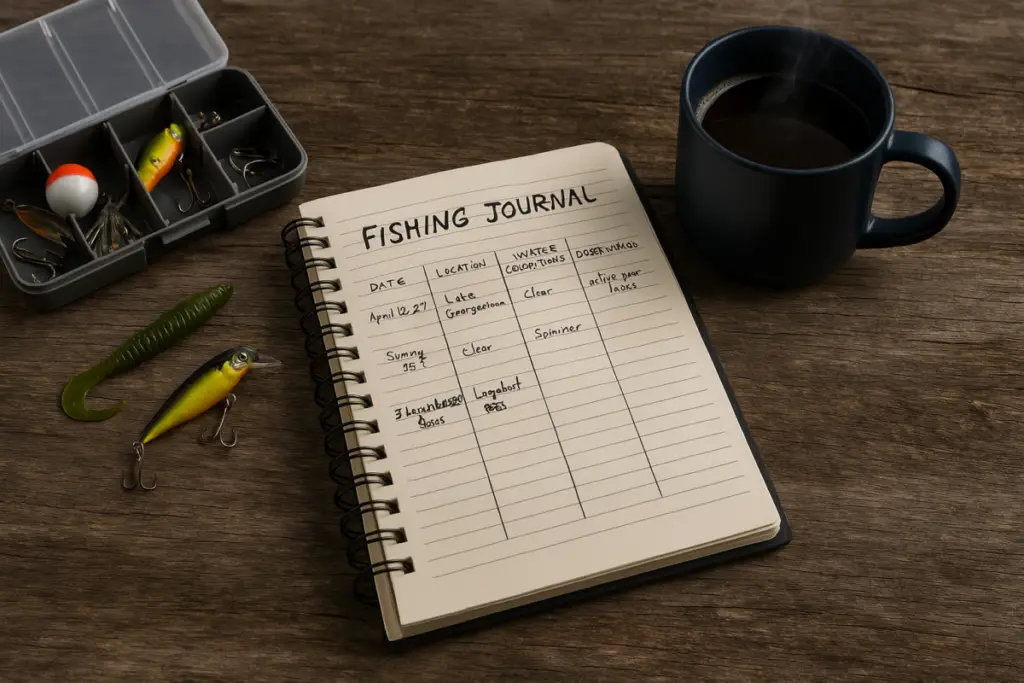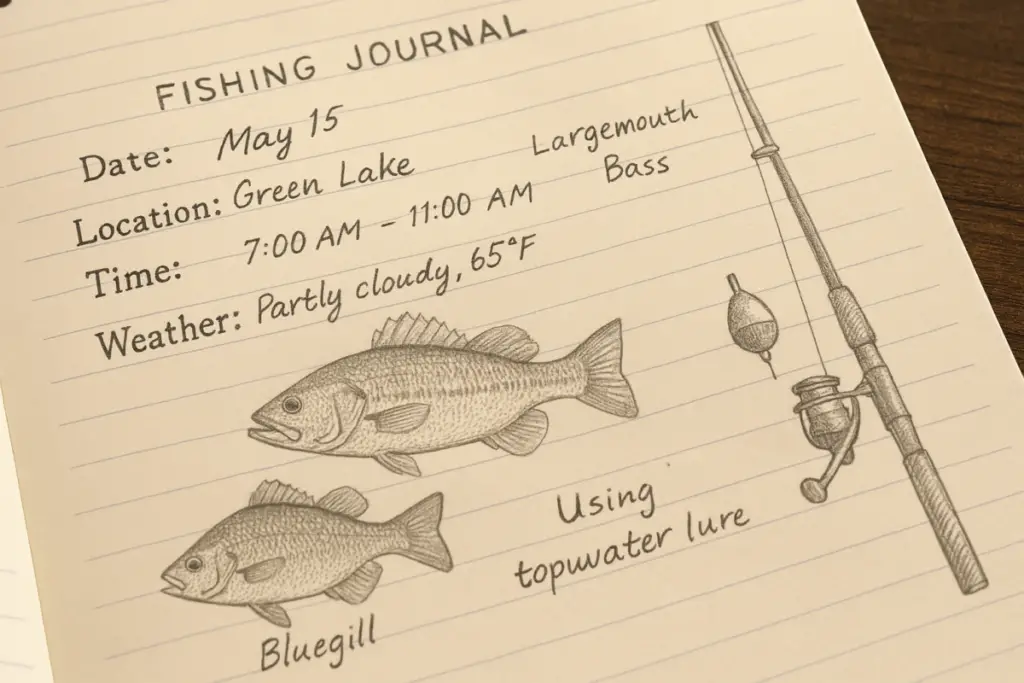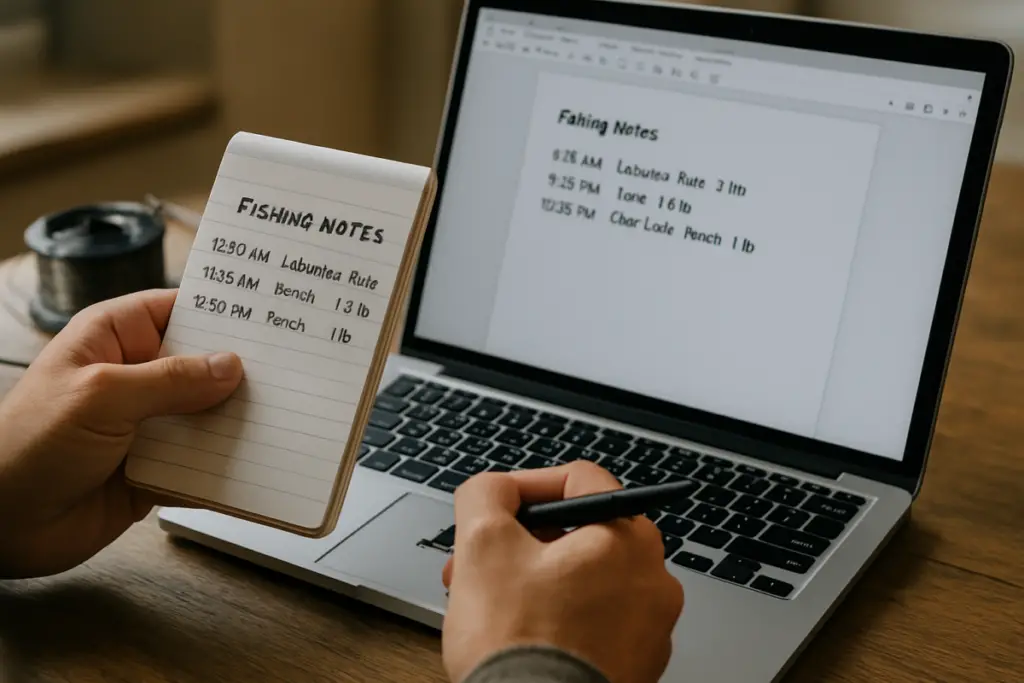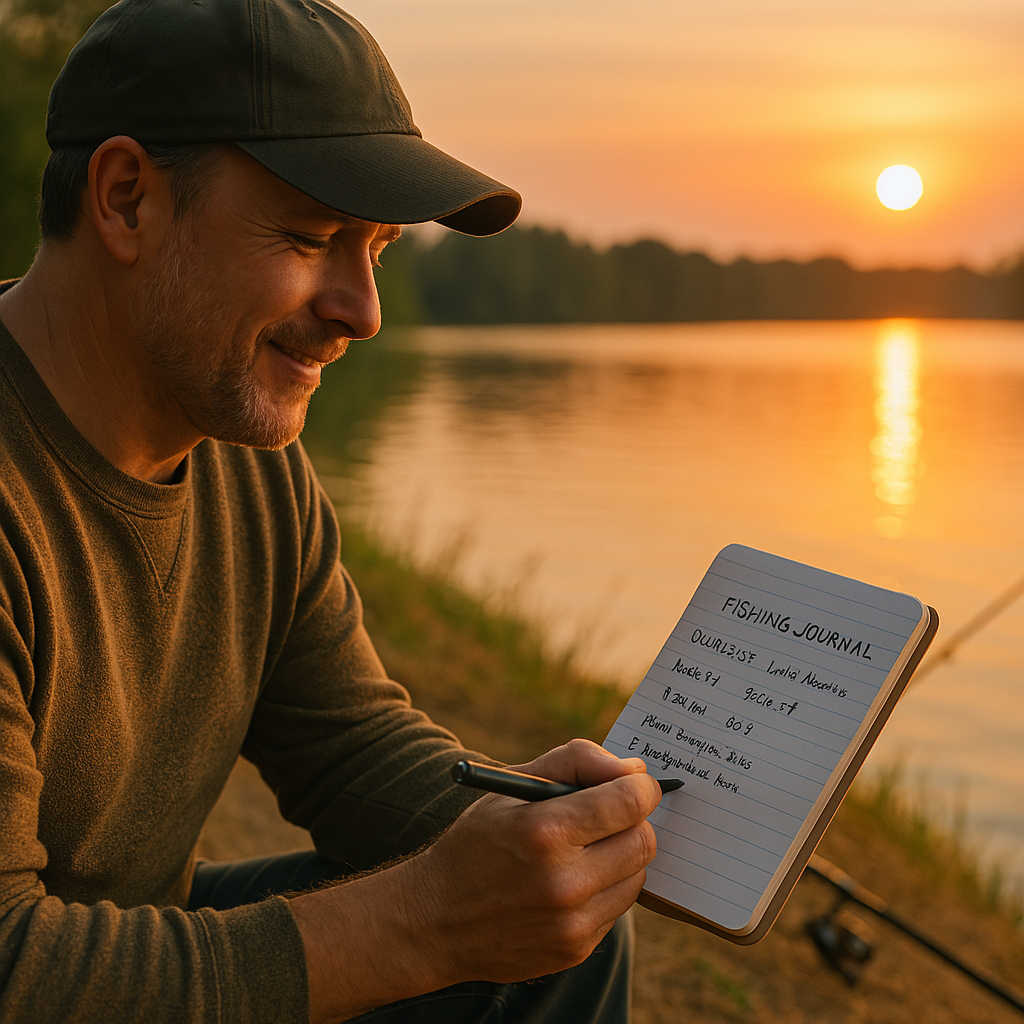
A Simple Tool That Makes a Big Difference
Ever finish a day on the water wondering why the fish were biting like crazy—or why they weren’t biting at all? We’ve all been there. You pack up your gear, head home, and by next weekend, you’ve forgotten what bait you used, what the weather was like, or even exactly where you were anchored.
That’s where a fishing journal comes into play. It might sound old-school, but logging your fishing trips is one of the easiest and most effective ways to improve your fishing game. Anglers who consistently track their outings often see noticeable improvements, catching more fish and gaining deeper insights into their local waters.
Keeping a simple log doesn’t take much time. You don’t need expensive equipment—just a notebook or a simple app, a few minutes after each outing, and you’re all set.
In this guide, you’ll learn:
- Exactly what to record in your fishing journal to spot valuable patterns.
- The practical benefits you’ll gain—like better catches, less guesswork, and clearer strategies.
- How to choose between a traditional paper journal and modern digital journaling apps.
Whether you’re new to journaling or you’ve tried before but didn’t stick with it, we’ll show you easy ways to make journaling a habit that’s actually fun (and definitely rewarding).
Interesting Fact: According to research from TakeMeFishing.org, anglers who log their trips consistently see significantly improved fishing success rates over time.
Ready to transform your casual trips into productive fishing expeditions? Let’s dive in.
Here’s the next section, “What Is a Fishing Journal?”, continuing with the conversational, engaging, and SEO-friendly style you’ve approved:
What Is a Fishing Journal?
Your Personal Fishing Playbook
At its core, a fishing journal is simply a record of your trips and catches—but in reality, it’s so much more. Think of it as your fishing memory, strategy guide, and secret weapon rolled into one easy-to-use notebook or digital log.
Keeping track of key details like location, weather conditions, bait used, and the results of your fishing efforts creates a personal database of experiences. Over time, you’ll start to see patterns emerge—patterns that can dramatically boost your fishing success.
Why bother keeping one? Well, a well-maintained fishing journal helps you:
- Identify what works (and what doesn’t): Quickly see which setups were effective on previous trips, and replicate them in similar conditions.
- Track seasonal patterns: Learn when fish become more active, what weather they prefer, and when certain species are most likely to bite.
- Spot fishing hotspots: Log exact locations where you consistently have success, making future trips more productive.
According to experts at Bassmaster, even professional anglers rely heavily on journals or logs, using their own historical data to plan tournaments and outings more effectively.
Key Information to Record in Your Fishing Journal
Not sure what to write down? Keep it simple and focus on these basics:
- Date & Time: Helps you track fishing trends across seasons and days.
- Location: Specific spots can yield dramatically different results, even within the same body of water.
- Weather Conditions: Temperature, wind, cloud cover, and barometric pressure can strongly influence fish behavior.
- Water Conditions: Clarity, temperature, current, and water level changes—all vital to understanding fish patterns.
- Bait & Tackle Used: Track the effectiveness of different gear and presentation styles.
- Fish Caught: Species, size, quantity, and any special notes (e.g., aggressive bites, deep water catches).
- Personal Observations: Anything unusual or insightful—like fish activity, local wildlife, or even the presence of other anglers.
Here’s an example of a clear, concise journal entry:

The Benefits of Keeping a Fishing Journal
Small Habit, Big Rewards
Keeping a fishing journal might seem like just another task at first—but stick with it, and you’ll quickly realize it’s one of the most valuable tools in your tackle box. Here’s how regularly logging your fishing trips pays off, making you a smarter, more successful angler:
1. Catch More Fish
Tracking your fishing outings helps you identify exactly what’s working and what’s not. Maybe you’ll discover that bass in your local lake bite better on cloudy days, or perhaps catfish prefer worms over artificial bait during spring. Armed with this knowledge, every future fishing trip becomes less guesswork and more strategic action.
2. Understand Fish Behavior
Fish patterns change constantly—based on weather, temperature, season, and even local fishing pressure. By reviewing your entries, you’ll start to notice these subtle patterns:
- Seasonal changes: Certain species biting more aggressively during specific months.
- Weather effects: Fish moving deeper in sunny, hot conditions or becoming active right before storms.
- Preferred baits and tactics: Discovering which lures consistently work during certain conditions.
3. Find Your Personal Fishing Hotspots
Ever have trouble remembering the exact spot where you landed that monster bass? A fishing journal solves that. Recording precise locations—whether by landmarks or GPS coordinates—means you’ll never lose a prime fishing spot again. Over time, you’ll compile a personal map of reliable fishing locations tailored exactly to your local waters.
4. Turn Slow Days into Valuable Insights
Not every fishing trip is filled with trophy catches. On slow days, a journal still provides critical insights. When you note conditions during these tougher outings, you learn exactly when to adjust your approach or even when to save a trip for better conditions. In short, fewer wasted trips, and more time spent effectively.
5. Build Confidence and Track Progress
Seeing your progress unfold over months (or even years) is hugely rewarding. You’ll clearly see your improvement—more consistent catches, larger fish, smarter tactics. And on tough days, a quick look back at past successes can quickly restore your confidence.
Quick Overview: Benefits at a Glance
According to experienced anglers featured by Bassmaster, consistent journaling is the key difference-maker that separates good anglers from truly great ones.
Essentials to Include in Your Fishing Journal
Keep It Simple, Keep It Useful
Your fishing journal doesn’t need to be overly detailed or complicated. In fact, simplicity is key—the easier your journal is to fill out, the more likely you’ll stick with it. But there are certain details that truly help you catch more fish down the line.
Here’s what experienced anglers consider essential information to log each trip:

Quick Reference Checklist
Every time you fish, try to include:
- Date and Time
Helps you track trends and patterns based on seasons and specific times of day. - Location Details
Note the name of the lake, river, or pond, plus specific spots like “north dock” or “south creek bend.” GPS coordinates or quick sketches can be a big help here. - Weather Conditions
Record temperature, wind conditions, cloud cover, and barometric pressure if possible. Fish behavior often closely aligns with weather shifts. - Water Conditions
Include water clarity, temperature, current, and level (high, low, or normal). Changes here directly influence where and how fish feed. - Bait and Tackle Used
Jot down your rod, reel, line, hooks, lures, and bait choice. Include lure size, color, and how you presented it (e.g., fast retrieve, slow jigging). - Fish Caught
Log species, number of fish, approximate size, and note whether you released or kept them. - Observations
Any extra details—fish jumping near weeds, presence of baitfish, unusual wildlife activity—can be invaluable later.
Sample Journal Entry
Here’s a practical example of how a quick entry might look:
Notice it’s straightforward, easy to read, and quick to fill out. Keeping it uncomplicated means you’ll actually use it every trip.
Optional Extras That Can Help
Want to dive a little deeper? Consider adding:
- Moon Phase: Particularly useful for night anglers and those targeting predatory fish.
- Photos: Snap quick pictures of fish, gear, or locations to visually track successes.
- Barometric Pressure: Some fish species, especially bass, respond strongly to barometric changes.
Remember, your journal should match your fishing style. Include what matters to you, and don’t stress about perfection. Even minimal logging is a huge step toward smarter, more consistent fishing success.
Digital vs. Traditional Journals
Paper or App: Which Fishing Journal Fits You Best?
Choosing between a traditional paper journal and a digital app or spreadsheet comes down to personal preference, fishing habits, and what helps you stay consistent. There’s no “best” method—just the best one for you.
Let’s break down each option clearly, so you can pick the right fit:
Traditional Paper Journal: Old-School, Reliable, Personal
Many anglers still love writing notes by hand. It feels personal, it never needs charging, and you can easily flip through memories anytime.
Why anglers like it:
- No tech required: Perfect for remote locations or those looking to unplug.
- Personal touch: Easy to add sketches, diagrams, or quick notes in the margins.
- Tactile keepsake: Feels like a meaningful, personal fishing story over time.
Potential drawbacks:
- Less searchable: Harder to quickly locate specific past details.
- Risk of damage or loss: Notebooks can be damaged by water, weather, or simply misplaced.
Pro Tip: Consider weatherproof journals like the Rite in the Rain Fishing Logbook, built specifically for fishing and outdoor adventures.
Digital Journal (Apps or Spreadsheets): Modern, Efficient, Data-Friendly
Digital journaling lets you log entries fast, use GPS tracking, integrate photos, and effortlessly search through past trips.
Why anglers prefer digital logs:
- Easy to search and organize: Quickly find past entries by date, location, or bait type.
- GPS & mapping features: Instantly mark and revisit exact locations through integrated mapping tools.
- Photo storage: Quickly add and save photos with your entries.
Potential drawbacks:
- Needs battery power and signal: Not ideal for very remote or prolonged trips.
- Can feel less personal: More data-driven, less tactile or sentimental.
Recommended apps to explore: Fishbrain, ANGLR, or MyCatch—all widely used and reviewed by anglers.
Quick Comparison Table: Paper vs. Digital Journals
Why Not Both?
Many anglers find a hybrid approach works great: quickly jot down notes by hand during trips, then transfer key details into a digital app or spreadsheet later. This way, you get the best of both worlds—personal, thoughtful notes and easy digital searchability.Remember, the goal is consistency and usefulness. Pick the method you’re most comfortable with and stick with it. Soon, you’ll wonder how you ever fished without your journal!

Practical Tips for Keeping a Fishing Journal
Make Journaling Easy and Enjoyable
The idea of logging your fishing trips might sound good at first—but let’s be honest, after a long day of fishing, it’s tempting to skip it. The key is making journaling easy, quick, and fun, so it feels less like a chore and more like a natural part of your routine.
Here are a few proven tips to help you stay consistent and make the most out of your fishing journal:
Tip 1: Keep It Accessible
Always have your journal or app handy. If it’s out of sight, it’s out of mind. Keep it:
- In your tackle box or boat compartment
- In your truck’s glovebox
- In your fishing backpack or gear bag
Pro tip: If you use an app, pin it to your phone’s home screen for instant access.
Tip 2: Write Entries Right Away
Don’t wait until later when details fade. Even quick notes right after fishing are more accurate than detailed ones hours or days later.
Quick entries can be as simple as:
“Caught 3 bass, cloudy, spinnerbait, near the docks. Windy.”
You can always expand the notes later if you want.
Tip 3: Use Voice Notes When Short on Time
If writing feels tedious after a long day, record quick voice notes into your smartphone instead. Later, when relaxed, transfer these into your journal or app. Many anglers use voice memos to easily capture fresh details that would otherwise be lost.
Tip 4: Keep Entries Short and Simple
If journaling starts feeling complicated, you’ll likely stop doing it. Stick to a quick and easy-to-fill template that includes just the essential details (weather, bait, fish caught, location). You’ll be more consistent and benefit more over time.
Tip 5: Set Regular Review Times
Schedule time—monthly or seasonally—to sit down with your journal and review past entries. Regular reflection helps you spot important patterns quickly:
- Are certain weather conditions consistently productive?
- Do specific locations or techniques produce reliably?
- Which lures earned their keep, and which should you reconsider?
Tip 6: Make It Personal and Fun
Your journal doesn’t need to be overly serious. Make it your own:
- Add quick sketches or doodles of fishing spots or memorable catches.
- Jot down funny stories, near misses, or memorable wildlife sightings.
- Celebrate “personal bests” or small victories with highlights or stickers.
Keeping it enjoyable means you’re much more likely to keep it going.
Conclusion: Your Fishing Journal—The Best Tool in Your Tackle Box
Fishing isn’t just about luck. It’s about learning from every trip—the good, the not-so-good, and everything in between. Keeping a fishing journal helps you turn ordinary outings into valuable insights, improving your skills each time you hit the water.Whether you go traditional with a notebook or modern with a fishing app, what matters most is that you’re keeping track consistently. The journal you maintain today becomes your secret weapon tomorrow, helping you catch more fish, waste less time, and better enjoy each adventure.

Ready to Get Started?
Grab a notebook or download your favorite app, and start logging your next fishing trip. It takes just a few minutes—but the benefits can last a lifetime.
Tight lines and happy journaling!
Frequently Asked Questions About Fishing Journals
Q1: Do I really need a fishing journal if I’m just a casual angler?
Absolutely! You don’t have to fish tournaments or every weekend to benefit from a fishing journal. Even casual anglers find journaling helpful—it makes your limited fishing time more productive, helps you remember successful strategies, and creates a personal record of enjoyable fishing memories.
Q2: What if I don’t catch anything—should I still log the trip?
Definitely. Logging trips with no catches can actually teach you a lot. You’ll begin to see patterns, like certain weather or water conditions that consistently result in less activity. Over time, this helps you avoid unfavorable conditions and makes you a smarter angler overall.
Q3: Are fishing journal apps expensive or difficult to use?
Not at all. Many popular fishing apps like Fishbrain or ANGLR offer free versions that are very user-friendly. Even their premium versions are reasonably priced. If you can use a smartphone, you can easily handle these apps—and you’ll probably love the extra features, like built-in maps and weather integration.
Q4: Can keeping a journal really help me catch bigger fish?
Yes—indirectly. A fishing journal helps you notice patterns and conditions that lead to success, which naturally helps you become more strategic about where, when, and how you fish. Over time, this means more frequent catches and better chances at landing bigger, trophy-worthy fish.
Q5: How detailed do my journal entries need to be?
Keep it simple. A useful entry can be as basic as a few short lines detailing conditions, bait, and catch results. If you have more time or interest, adding extra details (like sketches or personal notes) can enhance your records. But even quick notes provide valuable insights.
